Deliverability Guidelines
Why Is Your Email Sender Reputation Falling?
Struggling with declining email deliverability? Discover the factors impacting your sender reputation and how to improve it.

The phrase, “It’s not what you say, but how you say it,” is something many of us are familiar with. In the context of email sender reputation, this statement couldn’t ring truer.
Have you noticed a decline in your email deliverability or an increase in your emails being marked as spam? There could be several reasons behind this, and understanding the factors contributing to a falling sender reputation is crucial for maintaining a successful email marketing strategy.
Key Takeaways
- Maintaining a positive sender reputation involves addressing issues such as recipients reporting messages as spam, high bounce rates, sending emails to outdated or invalid addresses, and personalizing subject lines and segmenting email lists.
- The role of IP address and domain in sender reputation is crucial, requiring monitoring and maintenance, regular reputation checks, providing quality and dynamic emails, and ensuring opt-in consent from subscribers.
- Email volume can impact sender reputation, with consistent volume being preferred over sudden spikes or drops, excessive volume during promotional periods, and the need to balance frequency with content quality.
- Database cleaning is important in enhancing sender reputation, involving regularly removing invalid or inactive email addresses, utilizing email verification tools, and maintaining clean databases for improved targeting accuracy and engagement.
Understanding Email Sender Reputation
Understanding Email Sender Reputation is crucial for anyone involved in email marketing as it directly impacts the deliverability and effectiveness of their campaigns. Maintaining a positive sender reputation is essential for ensuring that your emails reach the intended recipients and don't end up in spam folders. Factors such as recipients reporting messages as spam, high bounce rates, and sending emails to outdated or invalid addresses can significantly damage your sender reputation. It's important to focus on best practices to improve your reputation, such as personalizing subject lines, segmenting email lists, and increasing engagement with your content.
When it comes to sender reputation, your IP address and domain also play a crucial role. These are the key identifiers that mailbox providers use to determine the legitimacy of your emails. Therefore, it's vital to monitor and maintain the reputation of both your IP address and domain. To improve your sender score, consider strategies such as conducting regular email reputation checks, providing quality and dynamic emails, and ensuring opt-in consent from subscribers.
Impact of Email Volume on Reputation

Maintaining a consistent volume of email campaigns is crucial to preserving a positive sender reputation and ensuring optimal deliverability and engagement. Fluctuations in email volume can have a significant impact on sender reputation, affecting deliverability rates and engagement levels.
Sudden spikes or drops in sending volume can trigger concerns from internet service providers (ISPs) and result in a tarnished sender reputation. Excessive email volume, particularly during promotional periods or holidays, may lead to higher unsubscribe rates and lower engagement, further impacting sender reputation.
Additionally, high email volume can result in increased spam complaints, which can directly influence the sender's reputation and potentially lead to being blacklisted. It's essential to monitor email volume closely and ensure that it aligns with subscriber expectations, delivering valuable and relevant content.
Balancing the frequency of email campaigns with content quality is pivotal in maintaining a positive sender reputation and sustaining healthy deliverability rates. By managing email volume effectively, senders can mitigate the risk of damaging their reputation and IP address credibility.
Importance of Database Cleaning
Regularly cleaning and maintaining the quality of our email database is crucial for our sender reputation and deliverability rates. By removing invalid or inactive email addresses, we can avoid triggering spam filters and improve our chances of reaching our intended recipients.
Utilizing email verification tools to filter out junk addresses will ensure that our database remains high quality, leading to better engagement and ultimately, a positive sender reputation.
Database Quality Impact
Database cleaning is essential for maintaining high deliverability rates and improving sender reputation for email marketing. A clean database directly impacts bounce rates and sender score, critical factors in determining sender reputation.
By regularly cleaning the email list, the risk of sending emails to outdated or invalid addresses is minimized, thus avoiding damage to sender reputation. Additionally, a clean database enhances targeting accuracy, ensuring that emails reach active and interested recipients, ultimately improving engagement.
Furthermore, maintaining a clean database is crucial for compliance with data protection regulations, contributing to overall email marketing effectiveness. Neglecting database quality impact can lead to the inclusion of spam traps, further deteriorating sender reputation.
Therefore, prioritizing database cleaning is paramount for sustaining a positive email sender reputation and achieving optimal deliverability rates.
Spam Filter Avoidance
To enhance email deliverability and sender reputation, it's imperative to prioritize the avoidance of spam filters through meticulous database cleaning and maintenance.
Implement regular database cleaning to remove invalid or inactive email addresses and reduce bounce rates.
Avoid using databases bought or rented from third parties to maintain a permission-based email list and improve sender reputation.
Personalize and use dynamic content to increase engagement and avoid triggering spam filters.
Scrutinize email marketing practices and request clearance from the blocked list to prevent negative impacts on sender reputation.
Prioritize opt-in lists and permission-based email marketing to ensure valid email addresses and avoid damaging sender reputation.
These measures can help divert your emails from high spam complaint rate and being marked as spam, ultimately reducing unsubscribe rates.
Email Deliverability Improvement
To ensure a seamless transition toward discussing the importance of database cleaning for email deliverability improvement, meticulous attention to database maintenance is essential for optimizing sender reputation and mitigating spam filter challenges.
Regularly cleaning the email database to remove invalid or inactive email addresses, and using email verification tools to filter out junk and inactive addresses, are critical steps.
Maintaining a consistent volume of email campaigns without sudden spikes or drops is crucial for improving sender reputation, as well as avoiding excessive emails, especially during special offers or holidays.
Implementing necessary changes before sending out emails, such as authenticating the domain using SPF, DKIM, and DMARC protocols, can significantly enhance email deliverability.
Monitoring sender score, bounce rates, and conducting regular email reputation checks are also essential for maintaining a positive email domain reputation.
Avoiding Spam Complaints

To maintain a positive sender reputation and avoid spam complaints, it's essential to use permission-based email lists to ensure valid email addresses and engage with recipients effectively. Implementing an opt-in list and avoiding the use of databases bought or rented from third parties is crucial in maintaining a good sender reputation.
Personalizing and using dynamic content can improve engagement and reduce the likelihood of being reported as spam. Limiting the number of emails sent and providing an easy unsubscribe option can help reduce unsubscribe rates and avoid negative sender reputation.
Scrutinizing email marketing practices and requesting clearance from the blocked list are also important steps to avoid damaging sender reputation. It's imperative to be mindful of complaint rates and the overall impact on the sender's IP address.
Recognizing Spam Traps

Recognizing spam traps is crucial for maintaining a positive sender reputation and minimizing the risk of damaging email deliverability. Spam traps are cunningly designed to weed out senders with poor practices. They come in two forms: pristine and recycled.
Pristine traps are newly created addresses that were never used for communication, while recycled traps are old addresses that have been repurposed for this exact function. Sending emails to these traps can severely impact sender reputation, resulting in a falling email sender reputation and a bad sender score. This, in turn, increases the likelihood of emails being flagged as spam, reducing the chances of reaching recipients' inboxes.
To recognize these traps, a meticulous approach to list hygiene is essential. Regularly cleaning email lists and implementing stringent opt-in strategies can help avoid triggering spam traps. Additionally, closely monitoring engagement metrics and promptly removing inactive or disinterested subscribers can mitigate the risk of falling into these traps.
Preventing Blacklisting

As we address the issue of preventing blacklisting, it's crucial to consider implementing comprehensive strategies to safeguard our email sender reputation.
Regular monitoring and cleaning of email lists, along with obtaining opt-in consent from subscribers, are essential steps to avoid being flagged as spam.
Additionally, utilizing authentication protocols such as SPF, DKIM, and DMARC can significantly improve our sender authentication and prevent our emails from being blacklisted.
Blacklist Prevention Strategies
Implementing double opt-in for email subscriptions ensures valid recipients and reduces the risk of being marked as spam, a vital strategy in preventing blacklisting.
To further safeguard your email sender reputation, regularly clean and update your email list to minimize bounce rates. Additionally, authenticate your domain using SPF, DKIM, and DMARC protocols to establish trust with email service providers.
Monitoring your sender reputation using tools like Return Path's Sender Score is crucial, allowing you to address any issues affecting deliverability promptly.
It's also essential to avoid purchasing or renting email lists without proper verification to prevent potential inclusion of spam traps and damaging your sender reputation.
Monitoring Email Deliverability
To ensure optimal email deliverability and prevent blacklisting, closely monitoring the engagement metrics and regularly checking the email sender reputation is imperative.
Monitoring email deliverability involves tracking key metrics such as bounce rates, open rates, and click-through rates. It's essential to use email verification tools to ensure the removal of invalid addresses and maintain a high-quality email list.
Additionally, monitoring IP reputation scores and the overall reputation of the sender's domain is crucial to avoid being blacklisted. Implementing authentication protocols like SPF, DKIM, and DMARC can enhance the sender's reputation and prevent emails from being flagged as spam.
Constant vigilance over the email sender reputation is vital for the success of any marketing campaign and to maintain a positive relationship with Internet Service Providers (ISPs).
Improving Sender Authentication
Improving sender authentication to prevent blacklisting involves bolstering the email sender reputation through the implementation of SPF, DKIM, and DMARC protocols.
To improve your email deliverability and maintain a strong email sender reputation score, consider the following:
- Implement SPF, DKIM, and DMARC protocols to authenticate your domain and prevent email spoofing.
- Regularly monitor and clean your email list to remove invalid or inactive addresses, reducing bounce rates and preventing blacklisting.
- Use double opt-in methods to organically grow your email list and ensure engaged subscribers, improving sender reputation and preventing blacklisting.
- Avoid using rented or bought email lists without proper verification to prevent high spam complaints and damage to your sender reputation.
Authentication and Sender Reputation
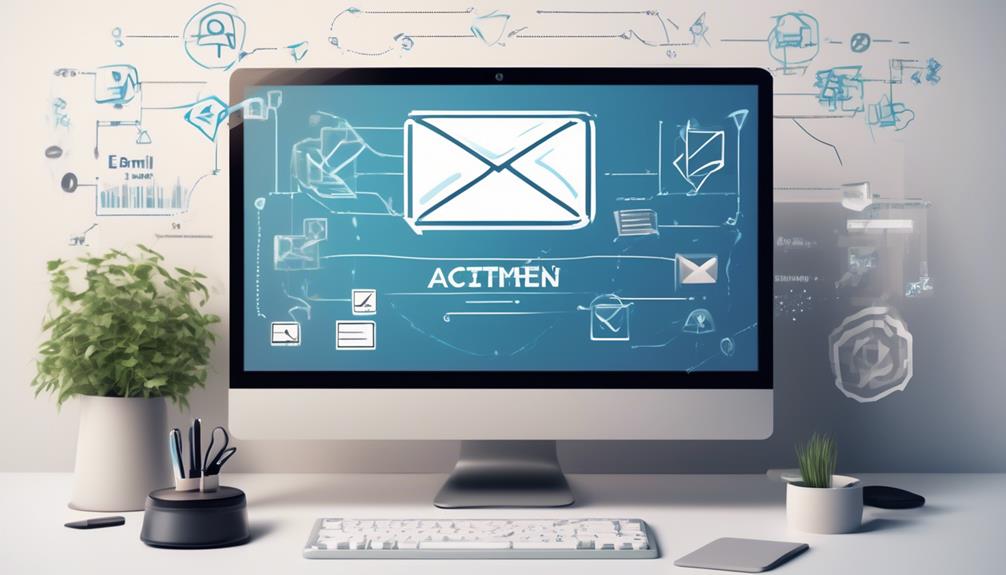
When establishing a strong sender reputation, it's essential to authenticate your domain using SPF, DKIM, and DMARC protocols to ensure the integrity and security of your email communications. By implementing these authentication methods, you can significantly improve your sender reputation, which directly impacts the deliverability of your emails.
Sender Policy Framework (SPF) allows domain owners to specify which IP addresses are authorized to send emails on behalf of their domain, reducing the likelihood of your emails being flagged as spam.
DomainKeys Identified Mail (DKIM) adds a digital signature to your emails, verifying that the message wasn't altered in transit and boosting your sender reputation.
Additionally, Domain-based Message Authentication, Reporting, and Conformance (DMARC) provides further visibility into your email sending practices, helping to maintain a positive sender reputation and reduce bounce rates.
These authentication protocols not only enhance your sender reputation but also contribute to a more effective email marketing strategy, improving your email sender score with Internet Service Providers (ISPs) and ultimately maximizing the success of your email campaigns.
Growing Your Email List Organically

Let's explore effective list building strategies and audience engagement techniques to grow our email list organically.
By offering valuable content and utilizing opt-in forms, we can attract subscribers who are genuinely interested in our emails.
Encouraging sharing and referrals, as well as engaging with our audience through interactive content, surveys, and feedback, will help maintain their interest and subscription.
List Building Strategies
To grow your email list organically, it's crucial to implement necessary changes before sending out emails. This includes authenticating your domain using SPF, DKIM, and DMARC protocols, as well as maintaining a clean mailing list by removing inactive or bounced email addresses.
When building your subscriber list, consider the following strategies:
- Utilize double opt-in to ensure high-quality leads.
- Regularly monitor and work to improve engagement metrics.
- Test and optimize your email marketing strategies to enhance open rates.
- Focus on best use practices for your IP address to maintain a high email sender score.
These strategies are essential to mitigate bounce rates, increase open rates, and enhance your email marketing effectiveness. As you master these list building techniques, your marketing efforts will yield better results.
Audience Engagement Techniques
Implementing audience engagement techniques is crucial for growing your email list organically and fostering meaningful connections with your subscribers.
To maintain a good sender score and protect your email sender reputation, it's essential to offer valuable content that encourages recipients to engage with your emails.
Use double opt-in methods to ensure that your audience genuinely wants to receive your communications.
Implement segmentation to send personalized and relevant content to different audience segments, thereby increasing engagement and reducing bounce rates.
Regularly cleaning your email list to remove invalid or outdated addresses is also vital in maintaining high deliverability rates.
Encourage subscribers to share and forward your emails to expand your audience organically, and pay close attention to creating compelling subject lines for your marketing emails to boost open rates and engagement.
Engaging Content for Better Reputation

Engaging content plays a crucial role in enhancing the reputation of email senders, as it directly impacts recipient engagement and email deliverability. To improve your sender reputation, email marketers should focus on creating engaging content that resonates with their audience.
Here are some strategies to consider:
- Personalized Subject Lines: Incorporate recipients' names in subject lines to increase open rates and engagement.
- Segmented Email Lists: Segment your email lists to deliver relevant content, which not only improves recipient engagement but also reduces spam complaints.
- Encourage Interaction: Encourage interaction with email content, such as prompting recipients to click on links or reply to the email, to boost engagement and improve sender reputation.
- Quality and Value: Ensure that the emails you send provide quality, dynamic content that offers value to subscribers. This will enhance your sender reputation and improve email deliverability.
Building a Robust Email Infrastructure

After emphasizing the importance of engaging content for improving sender reputation, the focus now shifts to building a robust email infrastructure to ensure the security and credibility of email communications.
To start, it's crucial to implement proper authentication protocols such as SPF, DKIM, and DMARC to secure the email infrastructure and prevent unauthorized use of your domain.
Regularly cleaning and maintaining your email lists is essential to reduce bounce rates and improve deliverability.
Additionally, utilizing a reliable email service provider with a strong sender reputation can significantly enhance the credibility of your emails and improve delivery rates.
Monitoring and analyzing engagement metrics is also vital for optimizing email content and delivery strategies, ensuring that your emails are relevant and valuable to recipients.
Lastly, investing in email verification tools can further guarantee that your emails are reaching valid and engaged recipients, ultimately strengthening your email sender reputation.
Building a robust email infrastructure is a critical component of successful email marketing and can significantly impact the overall effectiveness of your email campaigns.
Frequently Asked Questions
How Do I Fix My Email Sender Reputation?
We can fix our email sender reputation by focusing on key areas.
Implementing personalized subject lines, segmenting lists, and ensuring opt-in consent can improve engagement and reduce unsubscribes.
Monitoring subscriber preferences, sending relevant content, and soliciting feedback are crucial.
Regular reputation checks, quality emails, and using email verification tools all contribute to a strong sender score.
Maintaining a robust reputation is essential for effective email marketing and optimizing deliverability.
How Do I Increase My Sender Reputation Score?
To increase our sender reputation score, we need to focus on:
- Personalizing subject lines
- Segmenting email lists
- Encouraging interaction with our content
Regularly cleaning our email lists and using verification tools are crucial to:
- Avoid sending to invalid addresses
- Maintain a high sender reputation
By implementing these strategies, we can:
- Improve our engagement
- Enhance our overall reputation as email senders.
How Can I Improve My Sender IP Reputation?
We can improve our sender IP reputation by:
- Authenticating our domain with SPF, DKIM, and DMARC protocols.
- Regularly cleaning our mailing list to remove inactive or bounced email addresses.
- Growing our email list organically with double opt-in and avoiding sending emails to rented or bought lists without verification.
- Increasing engagement by encouraging interaction with email content.
- Segmenting email lists to send relevant content.
These strategies can have a positive impact on our sender IP reputation.
What Can Happen if a Sender's Reputation Becomes Poor?
If a sender's reputation becomes poor, email deliverability decreases, with messages redirected to spam folders or not delivered at all. Bounce rates rise due to sending to invalid addresses, damaging reputation.
Recipients are more likely to report as spam, further harming sender's reputation. Engagement and open rates decline, impacting email marketing effectiveness.
Blacklisting by service providers becomes a risk, severely hindering communication. This creates a challenging environment for successful email outreach.
What Can I Do to Improve My Email Sender Reputation?
Improving your email sender reputation can be crucial for better deliverability. Implementing effective strategies for email sender reputation, like regularly cleaning your email list, ensuring the quality of your content, and engaging with your subscribers can have a positive impact on your email deliverability and overall sender reputation.
Can a Falling Email Sender Reputation Cause Emails to Not Reach Inboxes?
Yes, a falling email sender reputation can definitely cause emails to not reach inboxes. To combat this, organizations should focus on implementing effective solutions for email delivery obstacles such as improving email authentication, maintaining a clean subscriber list, and consistently delivering engaging and relevant content to recipients.
Conclusion
In conclusion, maintaining a positive email sender reputation is crucial for successful email marketing.
Did you know that 85% of email traffic is considered to be spam? This statistic highlights the importance of implementing best practices to avoid falling into the spam category and damaging your sender reputation.
By understanding the factors that contribute to a negative reputation and taking proactive measures to improve it, businesses can ensure their emails reach their intended audience and achieve better engagement.
Natali – Editor in Chief (Strategy and Mastery, AI Expert) Natali, our Editor in Chief, is the driving force behind our content’s strategic direction. With a keen eye for detail and a deep understanding of market trends, Natali ensures that our content is top-notch and strategically aligned with our client’s goals. Her expertise in AI helps to seamlessly integrate advanced technology into our marketing strategies, pushing the boundaries of conventional marketing.
Deliverability Guidelines
What Drives Higher Email Open Rates?
Not just the subject line, but a combination of factors can significantly influence email open rates—discover these key elements for driving higher engagement.

In delving into what affects the rate at which emails are opened, it’s important to examine a number of crucial elements.
From the subject line to the timing of sending, various elements can significantly impact the likelihood of recipients engaging with our emails.
As we delve into these factors, we'll uncover actionable strategies that can help us drive higher open rates and ultimately enhance the effectiveness of our email campaigns.
Key Takeaways
- Subject lines play a crucial role in email open rates, with 47% of recipients deciding whether to open an email based on the subject line alone.
- Personalized subject lines can significantly boost open rates by 50%.
- Timing and frequency of email campaigns have a significant impact on open rates, and strategic planning is necessary to maximize engagement.
- Utilizing tactics such as A/B testing of subject lines, segmentation based on demographics or behavior, and incorporating numbers or statistics in subject lines can lead to higher open rates.
Understanding Email Open Rates
Understanding how recipients engage with emails is crucial for improving email open rates and optimizing email marketing campaigns. When it comes to email open rates, subject lines play a pivotal role. In fact, 47% of recipients decide whether to open an email based on the subject line alone. Crafting compelling subject lines that pique curiosity or offer a clear benefit can significantly impact open rates.
Additionally, considering the prevalence of mobile device usage, optimizing subject lines for mobile is essential. Research shows that 46% of all email opens occur on mobile devices, highlighting the importance of mobile-friendly subject lines.
Moreover, email marketing statistics indicate that personalized subject lines can boost open rates by 50%. This underscores the significance of segmentation and personalization in driving higher engagement. Understanding the preferences and behaviors of different segments within your email list can lead to more targeted and effective subject lines, ultimately increasing open rates.
Therefore, investing time in understanding recipient engagement, particularly in relation to subject lines, can yield substantial improvements in email open rates.
Key Factors Influencing Open Rates

Analyzing the factors that influence open rates is crucial for optimizing email marketing campaigns and increasing recipient engagement. When considering the key factors influencing open rates, it's essential to focus on subject lines, subscribers, and timing. Here's a breakdown of these key factors:
| Factor | Description | Impact |
|---|---|---|
| Subject Lines | Personalized, concise, and compelling subject lines significantly impact open rates. | Increases the likelihood of recipients opening emails. |
| Subscribers | Segmented subscriber lists lead to higher open rates compared to general email blasts. | Targeted content resonates more with specific groups. |
| Timing | Sending emails at optimal times, considering the audience's habits and time zones, affects open rates. | Increases the likelihood of emails being seen promptly. |
Understanding and leveraging these key factors can lead to improved email open rates, ultimately enhancing the effectiveness of email marketing campaigns. By focusing on personalized subject lines, targeted subscriber lists, and strategic timing, businesses can increase recipient engagement and drive better results from their email marketing efforts.
Calculating Average Open Rates
When calculating average open rates, it's essential to consider factors such as the impact of subject lines, timing, and frequency.
These elements can significantly influence the success of email campaigns and play a crucial role in determining open rates.
Factors Affecting Open Rates
To calculate the average open rates, email service providers divide the number of opens by the number of delivered emails. Open rates are a critical metric for evaluating the success of email marketing efforts.
Globally, the average open rate for email campaigns was 24% from 2015 to 2018, but it decreased to 21.3% in 2020. It's essential to note that open rates can fluctuate, and historical data indicates that periods of growth often follow declines in open rates.
Understanding your current open rate is crucial for refining and enhancing email marketing campaigns. The subject line, timing, and relevance of content are key factors that significantly influence open rates. Crafting compelling subject lines and delivering relevant content at the right time can lead to improved open rates, ultimately enhancing the effectiveness of email marketing efforts.
Impact of Subject Lines
Crafting compelling subject lines is a critical factor that significantly influences open rates, ultimately impacting the effectiveness of email marketing efforts. Personalized subject lines have been found to increase email open rates by 29.3% on average, compared to non-personalized ones.
A study by Statista revealed that the average open rate for personalized subject lines was 18.8%, significantly higher than the overall average. Furthermore, subject lines with 6 to 10 words deliver the highest open rates.
It's evident that subject lines play a pivotal role in driving email open rates. Understanding the impact of subject lines on open rates is crucial for optimizing email marketing strategies. By leveraging data on the effectiveness of various subject line styles, marketers can tailor their approaches to resonate with their audience and improve their email open rates.
Timing and Frequency
Timing and frequency of email campaigns significantly impact open rates, making it crucial to understand how these factors contribute to the effectiveness of email marketing efforts. To help grasp the impact of timing and frequency on open rates, we can calculate the average open rates based on different sending times and frequencies.
| Sending Time | Frequency | Open Rate |
|---|---|---|
| Morning | Daily | 26% |
| Afternoon | Weekly | 23% |
| Evening | Bi-weekly | 20% |
These figures illustrate the relationship between timing, frequency, and open rates. They emphasize the need for strategic planning when scheduling email campaigns. By analyzing open rates in relation to sending times and frequencies, marketers can optimize their strategies to maximize engagement and achieve higher open rates.
Factors Affecting Email Open Rates

When analyzing factors affecting email open rates, it's essential to consider a wide range of elements that can significantly impact the success of email campaigns. Subject lines play a crucial role in capturing the recipient's attention. They should be relevant, personalized, and optimized for mobile devices to increase open rates.
Additionally, the timing of when emails are sent can greatly influence open rates. Understanding the behavior of the target audience and leveraging data to determine the most optimal send time can lead to higher open rates.
It's also important to note that various small details, such as the use of emojis and preheader text, can impact open rates. These seemingly minor elements can make a substantial difference in whether an email is opened or ignored.
Furthermore, factors like list quality, previous open experience, and building trust with subscribers are key determinants of email open rates.
Strategies to Increase Open Rates
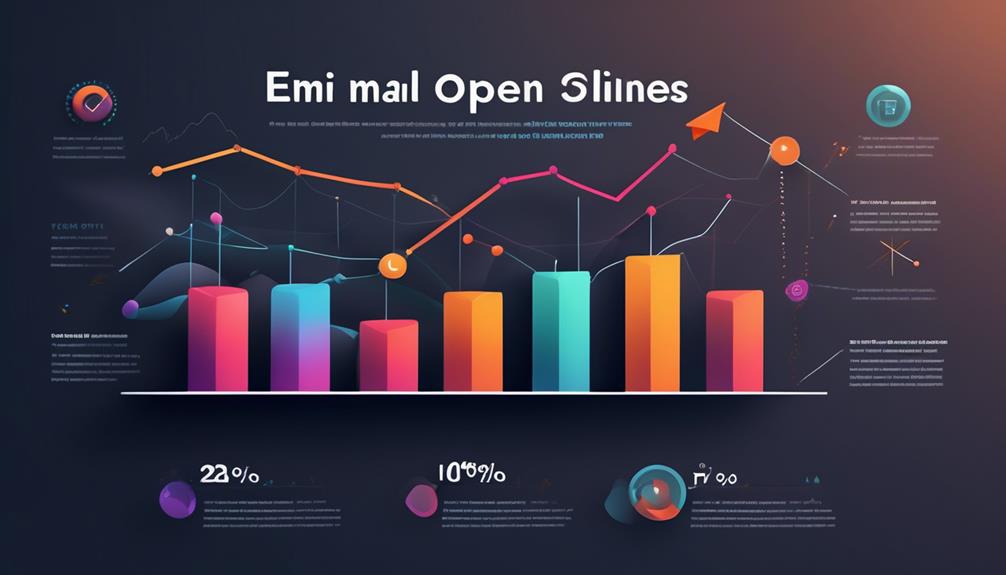
To increase email open rates, we can implement personalized subject lines and sender names, segment email lists, and optimize for mobile devices based on the latest research findings.
Personalizing subject lines with the recipient's name can lead to a 20% increase in open rates, while subject lines containing 6 to 10 words tend to deliver the highest open rates. Additionally, the sender name plays a crucial role, with 45% of subscribers deciding to open emails based on the sender's name.
Segmenting email lists can also significantly impact open rates, as a segmented list can generate a 94% open rate compared to 40% for a main blog subscriber list.
It's clear that timing is crucial as well, with research suggesting that Tuesday is the best day for high open rates, and subscribers are most likely to read emails at 10 am or 1 pm.
Moreover, mobile optimization is essential, as 81% of all emails are now opened and read on mobile devices.
Research-Backed Tactics for Higher Open Rates
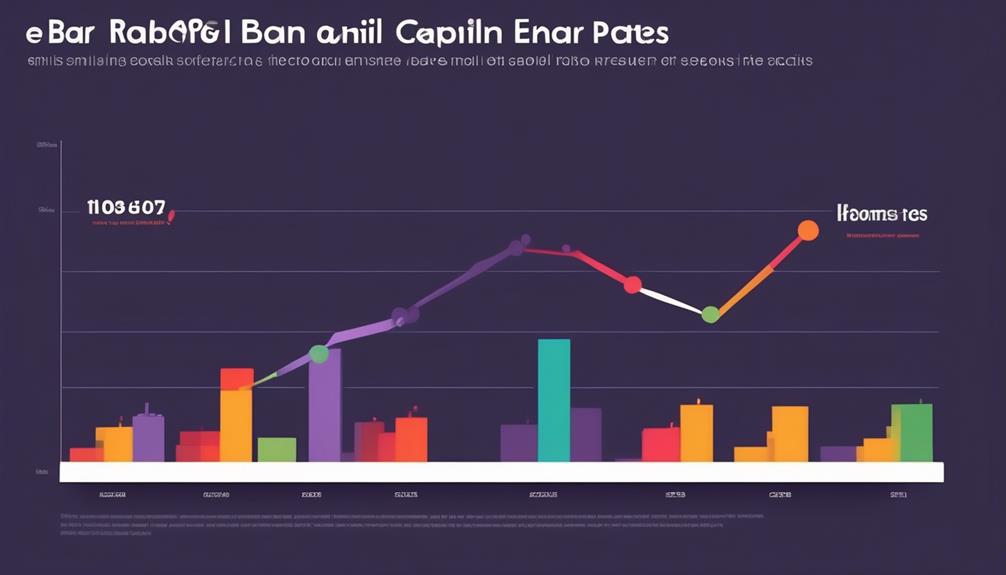
Implementing A/B testing of subject lines and optimizing send times based on subscriber behavior data are proven tactics for achieving higher email open rates. A/B testing involves sending two different subject lines to a subset of your email list and analyzing which one performs better in terms of open rates. This method allows you to refine your subject lines to be more appealing and effective.
Additionally, leveraging subscriber behavior data to determine the best times to send marketing emails can significantly impact open rates. By understanding when your audience is most active and engaged, you can schedule your email sends for optimal visibility and impact.
Research has shown that personalized subject lines can lead to a 26% higher open rate compared to generic ones. Personalization can involve using the recipient's name or crafting subject lines tailored to their specific interests and behaviors. Furthermore, concise and clear subject lines tend to perform better, as they quickly convey the purpose of the email and entice recipients to open it.
When it comes to send times, data-driven insights into when your audience is most likely to engage with emails can lead to a substantial increase in open rates. By implementing these research-backed tactics, you can strategically enhance your email open rates and drive better engagement with your audience.
Leveraging Segmentation for Better Open Rates

Leveraging segmentation in email marketing has been shown to significantly improve open rates. Segmented email lists generate a remarkable 94% open rate, compared to 40% for a main blog subscriber list. Despite this, 89% of marketers don't segment their email lists.
This is a missed opportunity, as segmenting lists can lead to higher open rates and click-through rates. By targeting specific subscriber groups with personalized content, businesses can experience higher open rates. Segmenting based on demographics or behavior and using dynamic content can greatly improve email open rates.
It's clear that leveraging segmentation is a powerful strategy for improving open rates. By dividing your subscriber list and tailoring content to specific segments, you can provide more relevant and valuable information to your subscribers. This approach leads to higher engagement and ultimately better open rates.
If you haven't started segmenting your email lists yet, consider taking the necessary steps to do so. The results could be well worth the effort in terms of increased open rates and overall campaign success.
Timing and Frequency Considerations

We've all received emails at odd hours or had our inboxes bombarded with multiple messages in a short timeframe. These experiences highlight the importance of timing and frequency in email marketing.
Finding the optimal send times and frequency can significantly impact open rates and engagement.
Personalization also plays a crucial role in ensuring that your emails are received and opened at the right time.
Optimal Send Times
It's essential to determine the most effective timing and frequency for sending your emails to optimize open rates and engagement with your audience.
Research shows that the optimal send times can significantly impact email open rates. By analyzing your audience's behavior, you can identify the times when they're most likely to engage with your content.
Additionally, consider the average open rate for emails in your industry as a benchmark for evaluating the effectiveness of your send times.
It's important to avoid bombarding your subscribers with too many emails in a short period, as this can lead to decreased engagement and potential unsubscribes.
Testing different sending frequencies and utilizing automation to schedule emails for specific times can help you find the sweet spot for maximizing open rates and overall engagement.
Frequency Impact
To optimize email open rates, carefully consider both the timing and frequency of your email sends, ensuring they align with your audience's preferences and behaviors. When it comes to frequency impact, finding the right balance is crucial.
Here's what to consider to maximize email open rates:
- Send emails at the most optimal time for your target audience.
- Avoid sending too many emails in a short period.
- Consider the time zone of your recipients.
- Test different sending frequencies to find the sweet spot.
- Use automation to schedule emails for specific times.
Personalization Effects
Finding the right balance in the frequency of email sends is crucial for optimizing open rates, and now we'll explore the impact of personalized timing and frequency in our audience's engagement. Understanding the preferences of our email subscribers is key to determining the best time to send emails. Research shows that sending emails on Tuesdays can lead to higher open rates, while weekends may result in lower engagement. Subscribers are most active at 10am and 1pm, making these ideal times for scheduling emails. Additionally, testing different sending frequencies can help identify the sweet spot for optimal open rates. It's important to note that open rates from mobile devices may vary, so ensuring that emails are mobile-friendly is essential for maximizing engagement.
| Timing | Open Rates |
|---|---|
| Tuesdays | High |
| Weekends | Low |
| 10am and 1pm | Optimal |
Optimizing Subject Lines for Improved Open Rates
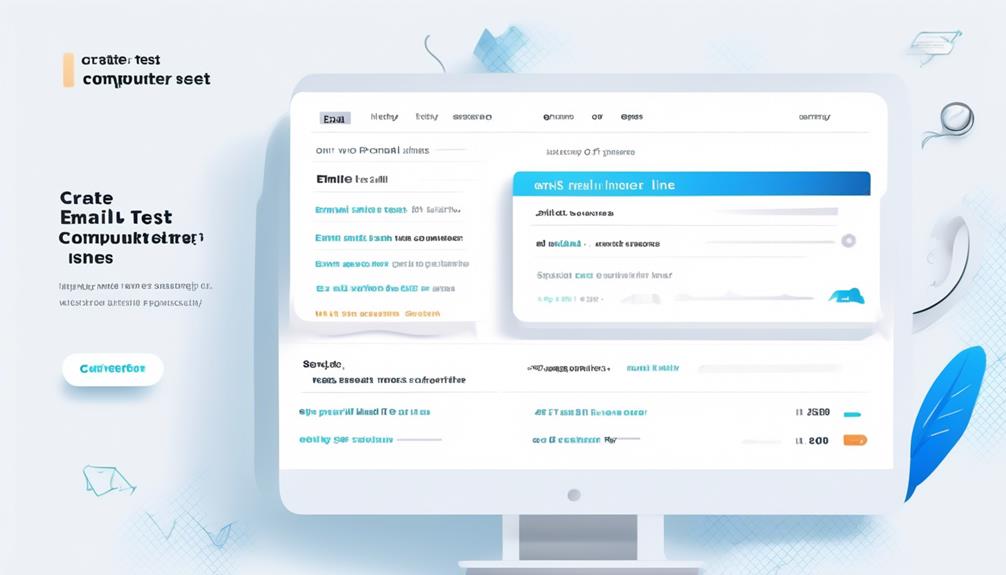
When crafting subject lines for email marketing campaigns, incorporating numbers or statistics can effectively grab the recipient's attention and increase open rates. Using concise and compelling subject lines is essential for capturing the reader's interest. Here are some key strategies for optimizing subject lines to improve email open rates:
- Incorporate Numbers or Statistics: Utilize data to make the subject line more compelling and informative.
- Personalize Subject Lines: Addressing the recipient by their name can create a sense of personal connection and increase the likelihood of the email being opened.
- Avoid Spam Trigger Words: Stay away from words or phrases that might trigger spam filters, as this can negatively impact open rates.
- Test Different Subject Lines: A/B testing can help identify the most effective subject lines for your audience.
- Keep it Concise: Use brevity to capture attention and communicate the essence of the email content effectively.
Frequently Asked Questions
What Drives Email Open Rates?
What drives email open rates?
Factors like timing, sender name, subject line, and list segmentation impact open rates.
Mobile optimization is crucial, with 81% of emails opened on mobile.
Subject lines with 6-10 words and personalization boost open rates.
Segmenting lists significantly impacts open rates, with a 94% open rate for segmented lists compared to 40% for unsegmented ones.
We should consider these factors to improve our email open rates.
What Element Increases an Email Open Rate?
Improving email open rates involves various elements.
Targeted timing, sender name, and subject lines play crucial roles.
Segmenting email lists rather than using a broad subscriber list can also yield higher open rates.
Personalizing subject lines, avoiding spam trigger words, and sending welcome emails are effective strategies.
These elements collectively contribute to boosting email open rates.
What Factors Can Impact the Open Rate of Your Email Campaigns?
We've found that several factors impact email open rates.
- Personalization, compelling subject lines, and optimized send times all play a crucial role.
- By tailoring content to our audience's preferences and behaviors, we've seen a significant increase in open rates.
- Additionally, utilizing A/B testing allows us to refine our strategies for maximum impact.
- These data-driven approaches have consistently driven higher engagement and conversion rates for our email campaigns.
How Can I Increase My Email Open Rate?
We increase email open rates by understanding our audience, personalizing subject lines, and delivering valuable content.
Mobile optimization and regular list cleaning are crucial.
Testing different subject lines and sending at the optimal time also helps.
Our approach involves segmenting email lists and providing value through content, which significantly impacts open rates.
What are the Key Factors in Driving Higher Email Open Rates?
The key factors in driving higher open rates in emails are captivating subject lines, personalized content, and optimized send times. A compelling subject line grabs the reader’s attention, while personalized content increases relevance. Moreover, sending emails at optimal times increases the likelihood of them being opened.
What are the Key Factors that Drive Higher Email Open Rates?
When it comes to achieving tips for higher open rates in email marketing, personalization is crucial. Tailoring subject lines and content to resonate with the recipient can significantly boost open rates. Additionally, using engaging and relevant content, optimizing send times, and avoiding spam triggers are also key factors for success.
Conclusion
In conclusion, email open rates are influenced by various factors such as subject line, sender name, timing, mobile optimization, and personalization.
One interesting statistic to note is that personalized subject lines are 26% more likely to be opened.
By focusing on these factors, marketers can drive higher open rates and improve the effectiveness of their email campaigns.
Natali – Editor in Chief (Strategy and Mastery, AI Expert) Natali, our Editor in Chief, is the driving force behind our content’s strategic direction. With a keen eye for detail and a deep understanding of market trends, Natali ensures that our content is top-notch and strategically aligned with our client’s goals. Her expertise in AI helps to seamlessly integrate advanced technology into our marketing strategies, pushing the boundaries of conventional marketing.
Deliverability Guidelines
6 Key Strategies to Maximize Inbox Placement Rates
Keen to improve your email deliverability? Discover the six key strategies to maximize inbox placement rates and unlock greater reach and impact.
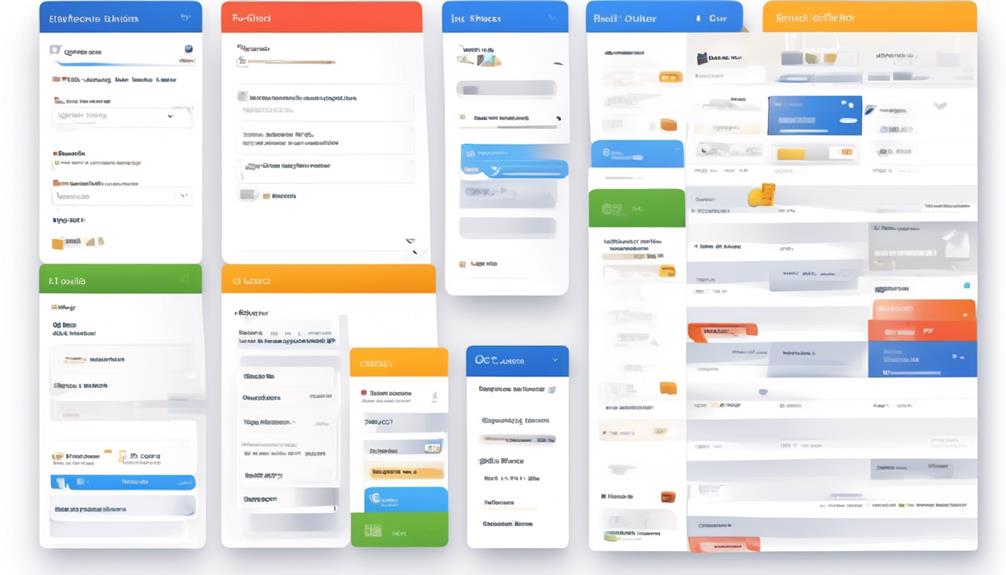
In the bustling world of online messaging, picture your email as a meticulously prepared note sealed in a bottle, aiming to safely traverse the ocean of spam filters and promotional folders to arrive at the destination of your recipient’s inbox.
In an age where email deliverability is paramount, understanding the six key strategies to maximize inbox placement rates becomes essential for anyone seeking to ensure their messages are seen and engaged with.
From maintaining a pristine sender reputation to optimizing content for placement, these strategies hold the key to unlocking greater reach and impact in the realm of email marketing.
Key Takeaways
- Maximizing inbox placement rates is crucial for the success of email marketing campaigns.
- Maintaining a high sender reputation is closely tied to achieving good inbox placement rates.
- Engaging and relevant content, as well as compelling subject lines, increase subscriber engagement.
- Implementing email authentication protocols and avoiding spam triggers are vital for improving inbox placement rates.
Importance of Inbox Placement Rate
Maximizing inbox placement rates is crucial for ensuring that our emails reach their intended recipients and drive engagement. A high inbox placement rate is vital for the success of our email marketing campaigns. It directly impacts the effectiveness of our outreach and the overall success of our marketing efforts. Without a high inbox placement rate, our emails may end up in spam folders or be blocked by spam filters, significantly reducing their visibility and potential engagement.
Maintaining a high sender reputation is closely tied to inbox placement rates. Sender reputation, which is influenced by factors such as spam complaints and email engagement, plays a critical role in email deliverability. By improving our inbox placement rate, we can enhance our sender reputation, thereby increasing the likelihood of our emails being delivered to the recipients' inboxes.
Effective email marketing relies heavily on the ability to reach the target audience. By focusing on improving our inbox placement rate, leveraging email deliverability tools, and optimizing our email content, we can ensure that our messages aren't only delivered but also receive the attention they deserve.
Ultimately, a high inbox placement rate is fundamental to achieving success in email marketing.
Factors Influencing Inbox Placement

As we examine the factors influencing inbox placement, it's crucial to consider the various elements that impact the deliverability of our emails.
Understanding the factors for placement and the metrics associated with inbox placement will provide valuable insights into optimizing our email marketing strategies.
Factors for Placement
In our analysis of factors influencing inbox placement, it's imperative to consider the sender's reputation, email content, and engagement metrics as key determinants.
A sender's reputation, based on factors such as email delivery and Domain Keys Identified Mail (DKIM) authentication, significantly impacts inbox placement rates (IPR).
Email content, including the presence of spam trigger words and the overall quality of the content, directly influences the success of email marketing campaigns in reaching the inbox.
Additionally, engagement metrics, such as email open rate and recipient interaction, play a crucial role in achieving good inbox placement.
Regularly conducting an inbox placement test can provide valuable insights into the effectiveness of email list management and content strategies.
Understanding these factors is paramount to improving inbox placement and maximizing the impact of email marketing efforts.
Inbox Placement Metrics
Understanding the intricacies of inbox placement metrics is essential for optimizing email deliverability and enhancing the effectiveness of email marketing campaigns. To achieve a high inbox placement rate, it's crucial to focus on several key metrics:
- Email Verification: Regularly verify email addresses to ensure the list is clean and up-to-date.
- Content: Create engaging and relevant content to increase subscriber engagement and reduce the likelihood of emails being marked as spam.
- Subject Lines: Craft compelling subject lines that encourage recipients to open the emails.
- Spam Complaint Rate: Monitor and minimize the rate of spam complaints by providing valuable and anticipated content.
Optimizing Email Content for Placement
To maximize inbox placement rates, email content must be optimized to resonate with specific audience segments, thereby increasing engagement and deliverability. Tailoring email campaigns to resonate with the intended recipients is crucial for achieving good inbox placement rates.
Implementing email authentication protocols such as Sender Policy Framework (SPF), DomainKeys Identified Mail (DKIM), and Domain-based Message Authentication, Reporting, and Conformance (DMARC) is essential to establish the sender's legitimacy and improve inbox placement.
Additionally, avoiding spam traps and maintaining a good sender reputation are vital for ensuring inbox placement. It's imperative to create engaging content that encourages recipients to interact with and respond to your emails.
By segmenting email lists and monitoring engagement metrics, senders can enhance their inbox placement rates. Regularly cleaning up email lists and eliminating inactive subscribers can further improve inbox placement.
Therefore, optimizing email content for placement involves a strategic combination of email authentication, domain reputation management, and engaging with your emails to ensure high deliverability and inbox placement rates.
Building and Maintaining Sender Reputation

Building and maintaining sender reputation requires consistent adherence to email authentication protocols and proactive management of engagement metrics to ensure high deliverability and inbox placement rates. Email marketers must prioritize the following best practices:
- Segmentation: Divide your email lists based on user behavior, preferences, and demographics to send targeted and relevant content, improving engagement and reducing the risk of being marked as spam.
- Authentication Protocols: Implement SPF, DKIM, and DMARC to verify the authenticity of your emails, preventing spoofing and boosting sender reputation.
- Monitoring Delivery Rate and Unsubscribe Rate: Regularly monitor these metrics to identify any issues with your email campaigns and take corrective actions promptly to maintain high deliverability and minimize unsubscribes.
- Avoiding Spam Folders: Tailor your content to align with subscriber expectations, use clear subject lines, and avoid spam trigger words to minimize the risk of your emails being directed to spam folders.
Enhancing Recipient Engagement

To enhance recipient engagement, we must focus on improving email open rates and click-through rates.
By delivering relevant content and personalized experiences, we can capture the attention of our recipients and encourage them to interact with our emails.
Monitoring and analyzing these engagement metrics will provide valuable insights for optimizing our email performance and increasing inbox placement rates.
Email Open Rates
Improving email open rates is a critical component of enhancing recipient engagement and maximizing inbox placement rates. To enhance email open rates, we must focus on several key strategies:
- Subject Line Optimization: Crafting compelling and concise subject lines that entice subscribers to open the email.
- Segmentation and Personalization: Tailoring content to specific segments of your subscriber list to increase relevance and engagement.
- A/B Testing: Testing different elements of your email campaigns, such as subject lines, send times, or content, to identify what resonates best with your audience.
- Engaging Content: Providing valuable, relevant, and visually appealing content that encourages recipients to open and interact with your emails.
Implementing these strategies can significantly improve email open rates, leading to better recipient engagement and ultimately higher inbox placement rates.
Click-Through Rates
Enhancing recipient engagement through maximizing click-through rates builds upon the foundation of improved email open rates. This emphasizes the importance of driving continued interaction and response from subscribers.
To boost your inbox placement, consider the impact of click-through rates on affecting inbox placement. Engaging and relevant content, personalized emails, and audience segmentation are key factors in improving click-through rates.
Monitoring and analyzing email engagement metrics is crucial for understanding recipient behavior and optimizing click-through rates. Implement A/B testing for email subject lines, content, and design to identify strategies that improve click-through rates.
Additionally, leveraging interactive elements such as buttons and compelling calls-to-action can significantly improve click-through rates and drive recipient engagement.
These strategies play a vital role in improving email deliverability and maximizing inbox placement rates.
Implementing Email Authentication and Verification

We regularly implement email authentication protocols like SPF, DKIM, and DMARC to verify sender identity and enhance inbox placement rates. By doing so, we ensure that our emails are recognized as legitimate and not classified as spam by Internet Service Providers (ISPs).
In addition to this, we employ real-time email verification to validate the authenticity of email addresses, reducing the risk of delivery issues caused by invalid or inactive addresses.
Furthermore, we actively monitor and address spam complaints to maintain a healthy email sender reputation, which is crucial for maximizing inbox placement rates.
Minimizing the use of spam trigger words in our email content is another strategy we employ to mitigate the risk of being labeled as spammy and to improve our inbox placement rates.
Lastly, we utilize email deliverability tools, such as spam filter testing and domain reputation monitoring, to identify and resolve any issues that could negatively impact our inbox placement rates.
These strategies collectively contribute to our efforts to maximize inbox placement rates and ensure the successful delivery of our emails.
Frequently Asked Questions
How Can I Improve My Inbox Placement Rate?
We can improve inbox placement rates by:
- Optimizing sender reputation
- Crafting engaging subject lines and content
- Maintaining a clean email list
Employing authentication protocols like SPF, DKIM, and DMARC ensures trustworthiness.
Regularly monitoring delivery metrics and adjusting strategies accordingly is crucial.
Utilizing a dedicated IP address and collaborating with reputable email service providers can also bolster inbox placement.
Employing these tactics will likely lead to improved inbox placement rates for your email campaigns.
How Can I Increase My Email Delivery Rate?
We can increase our email delivery rate by optimizing sender reputation, authentication, and content.
Monitoring our sender score and addressing any issues that may negatively impact it's crucial.
Implementing SPF, DKIM, and DMARC authentication protocols helps improve deliverability.
Crafting engaging and relevant content, avoiding spam triggers, and maintaining a clean subscriber list are essential.
Constantly monitoring and refining these factors will steadily improve our email delivery rate.
What Is a Good Inbox Placement Rate?
A good inbox placement rate typically exceeds 95%, ensuring email delivery to the primary inbox. This enhances recipient engagement and interaction.
It differs from email deliverability rates, which encompass various folders. A high inbox placement rate fosters increased engagement, while a low rate can lead to missed opportunities.
Calculating inbox placement rate is crucial in assessing email campaign effectiveness and the success of email marketing efforts.
What Is Your Strategy to Ensure High Email Deliverability?
To ensure high email deliverability, we focus on maintaining a clean and engaged subscriber list. We do this by implementing proper authentication protocols and regularly monitoring our sender reputation.
Additionally, we prioritize creating relevant and valuable content. This helps to drive engagement and minimize the risk of being marked as spam.
Are the Key Strategies for Maximizing Inbox Placement Rates Effective?
Maximizing inbox placement rates is crucial for successful email marketing. Key strategies to boost email placement rates include maintaining a clean email list, using relevant and engaging content, and adhering to email delivery best practices. Employing these tactics will significantly improve your email placement rates and increase the chances of reaching your target audience.
Conclusion
In conclusion, maximizing inbox placement rates is crucial for the success of email marketing campaigns.
By implementing the six key strategies mentioned, we can significantly improve our email deliverability and engagement.
For example, a company saw a 20% increase in open rates and a 15% decrease in bounce rates after implementing email authentication and verification protocols. This led to a noticeable improvement in inbox placement rates and overall campaign performance.
These strategies are essential for achieving successful email marketing outcomes.
Natali – Editor in Chief (Strategy and Mastery, AI Expert) Natali, our Editor in Chief, is the driving force behind our content’s strategic direction. With a keen eye for detail and a deep understanding of market trends, Natali ensures that our content is top-notch and strategically aligned with our client’s goals. Her expertise in AI helps to seamlessly integrate advanced technology into our marketing strategies, pushing the boundaries of conventional marketing.
Deliverability Guidelines
What Drives Top Email Deliverability for Marketers?
Curious about the key drivers behind top email deliverability for marketers? Uncover the crucial factors shaping the success of your email campaigns.
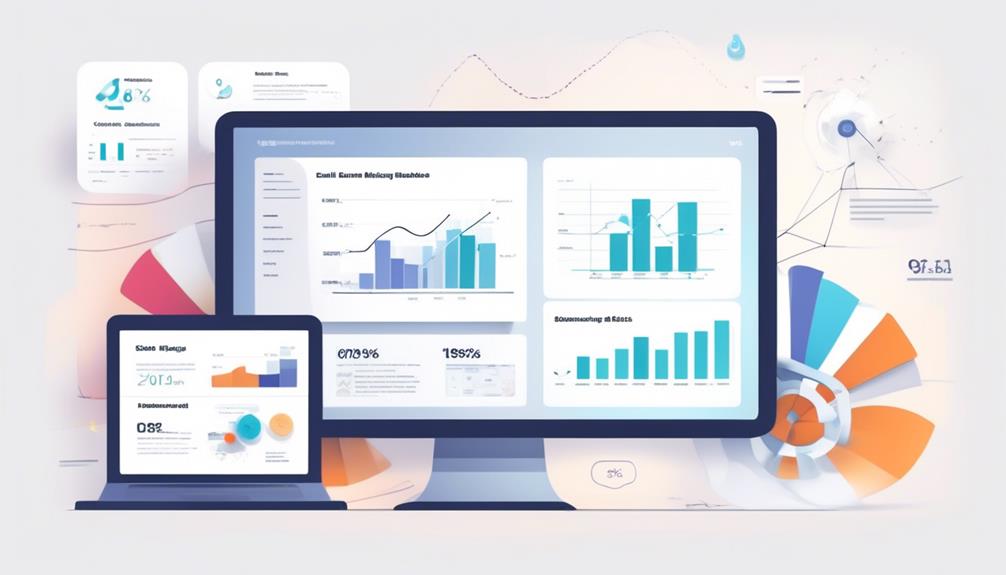
As marketers, we’re all too familiar with the disappointment that comes from pouring effort into an email campaign, just for it to land in the unwanted spam folder. So, what genuinely ensures high deliverability for our emails?
There are multiple factors at play, from the reputation of our sender IP address to the content of our emails. But, how do these elements interact to ensure our messages reach the intended recipients' inboxes?
Let's explore the key drivers behind top email deliverability and how they can shape the success of our marketing efforts.
Key Takeaways
- High email deliverability is crucial for successful email marketing campaigns.
- Sender and IP reputation significantly impact email deliverability.
- Compelling email content and subject lines drive engagement and increase deliverability.
- Choosing the right Email Service Provider (ESP) and implementing best practices are essential for achieving top email deliverability.
Email Deliverability Importance
Why is email deliverability crucial for marketers to achieve successful engagement and avoid detrimental practices?
Email deliverability is of paramount importance in our email marketing strategy. It directly impacts our ability to reach our audience and drive engagement. High email deliverability ensures that our emails are reaching the recipients' inboxes, increasing the likelihood of being seen and acted upon. This, in turn, positively influences our engagement rates.
On the other hand, poor deliverability can result in emails being marked as spam or not being delivered at all, significantly hampering our marketing efforts.
To achieve good email deliverability, we must focus on various factors such as sender reputation, domain reputation, inbox placement, and avoiding spam traps. Sender reputation, often measured through a sender score, is a critical metric that ISPs and email providers use to evaluate the trustworthiness of our emails. By working with deliverability experts and maintaining a positive sender reputation, we can enhance the chances of our emails reaching their intended recipients.
Additionally, monitoring engagement metrics and employing proper technical setup and email authentication are vital steps in ensuring high email deliverability.
Ultimately, understanding the importance of email deliverability and implementing best practices is essential for the success of our email marketing endeavors.
Factors Influencing Deliverability

Email deliverability is influenced by a variety of factors, including:
- IP address reputation
- Sender reputation
- Email subject line and content
- Choice of Email Service Provider (ESP)
Crafting compelling email subject lines and content, as well as selecting a reputable ESP, are crucial for ensuring deliverability and avoiding the spam folder.
Other important factors include:
- Email list quality
- Proper technical setup
- Email authentication
- Engagement metrics monitoring
Maintaining a high-quality email list, free from bad addresses and role-based accounts, is essential for good deliverability rates. Proper technical setup, email authentication, and monitoring engagement metrics also play a pivotal role.
Additionally, factors such as:
- Email sending frequency
- Volume
- Occurrence of spam complaints
Can significantly influence email deliverability. Marketers must be mindful of these factors to ensure that their emails reach the intended recipients' inboxes and avoid being flagged as spam by ISPs.
Sender and IP Reputation
The reputation of the IP address and sender plays a critical role in determining email deliverability, directly impacting the success of marketers' email campaigns. Maintaining a positive sender and IP reputation is crucial for achieving high deliverability rates.
Here's what drives sender and IP reputation:
- Sender Policy Framework (SPF): Implementing SPF helps verify that the sender's IP address is authorized to send emails on behalf of the domain, thus enhancing sender reputation.
- Email Authentication: Properly authenticating emails using methods such as DomainKeys Identified Mail (DKIM) and Domain-based Message Authentication, Reporting, and Conformance (DMARC) can significantly boost IP reputation and deliverability.
- Shared IP Address: Sharing an IP address with other senders can impact reputation. Understanding how shared IPs may affect deliverability is essential for maintaining a positive reputation.
- Email Infrastructure and Volume: The quality and volume of emails sent, as well as the overall email infrastructure, heavily influence sender and IP reputation. Keeping these factors in check is vital for ensuring high deliverability rates.
Email Content and Subject Line

Crafting compelling subject lines and email content is essential for capturing recipient attention and driving engagement in email marketing campaigns.
When creating email content, it's crucial to avoid spam-like words and tactics to prevent triggering spam filters, which can negatively impact deliverability rates.
Additionally, aligning subject lines with the email content is vital for maintaining trust and engagement with recipients and avoiding spam complaints.
Testing and personalizing email content can optimize delivery and engagement rates, positively impacting brand reputation and customer experience.
It's also important to consider technical aspects such as SPF and DKIM authentication to ensure that mailbox providers recognize emails as legitimate.
Optimizing the text-to-image ratio and including clear calls to action can enhance the effectiveness of email content, leading to improved email engagement.
Email Service Provider Considerations
When evaluating Email Service Providers (ESPs) for optimal deliverability, technical competence and experience are crucial factors to consider. It's essential to select an ESP that understands the intricacies of email deliverability and can provide the necessary technical support.
Here are key considerations when choosing an ESP:
- Impact on Deliverability: Consider how switching ESPs can affect deliverability, as the transition process can impact sender reputation and deliverability rates.
- Throttling Understanding: Evaluate whether the ESP comprehends the concept of throttling and its significance in maintaining a good sender reputation and deliverability rate.
- Technical Setup and Authentication: Assess the ESP's technical setup and authentication protocols to ensure the authenticity of emails sent through their platform.
- List Hygiene and Segmentation: Prioritize an ESP that emphasizes email list hygiene, segmentation, and cleaning to maintain high-quality email lists and improve engagement.
Selecting the right ESP can significantly impact the success of email campaigns and the overall deliverability rate. By considering these factors, marketers can enhance their chances of achieving optimal email deliverability and maximizing the effectiveness of their email marketing efforts.
List Quality and Hygiene

To ensure optimal email deliverability, maintaining list quality and hygiene is imperative for marketers. Poor list hygiene and low-quality email addresses can significantly impact the deliverability of email marketing campaigns. Implementing best practices such as verifying emails, regularly cleaning and updating lists, and segmenting based on subscriber preferences are essential for achieving a good email deliverability rate. The table below illustrates the impact of list quality and hygiene on email deliverability.
| Impact of List Quality and Hygiene on Email Deliverability | ||
|---|---|---|
| Best Practices | Poor List Hygiene | Email Marketing Strategies |
| – Verify emails before adding to the list | – High bounce rate | – Implement double opt-in methods |
| – Segment lists based on subscriber preferences | – Increased spam complaints | – Avoid purchasing or renting low-quality email lists |
| – Use dedicated IP for email delivery | – Risk of being labeled as a spammer | – Regularly clean and update email lists |
Maintaining good list hygiene and quality is crucial for a successful email marketing strategy. By adhering to best practices and ensuring the cleanliness of email lists, marketers can improve their email deliverability rates and enhance the effectiveness of their campaigns.
Frequently Asked Questions
What Factors Influence Email Deliverability?
Factors influencing email deliverability include:
- IP address reputation
- Sender reputation
- Email content
- ESP reliability
- Email list quality
- Technical setup
- Authentication
- Engagement metrics
Sending frequency, volume, and recipient behavior also impact deliverability.
Maintaining a positive reputation, using engaging content, and adhering to best practices are critical.
Monitoring and adjusting these factors regularly is key to achieving top email deliverability.
What Are the Key Ways to Improve Email Deliverability in Email Marketing?
Improving email deliverability involves maintaining a positive sender reputation, optimizing email content, and selecting a reliable Email Service Provider.
We prioritize IP address reputation, sender reputation, and email list quality to enhance deliverability. By focusing on these factors, we mitigate the risk of spam filters and increase the likelihood of reaching recipients' inboxes.
Our approach emphasizes data-backed strategies to optimize email deliverability and achieve marketing objectives.
What Is the Average Email Deliverability Rate for Marketers?
Our average email deliverability rate as marketers hovers around 85-90%.
Factors like sender reputation, email content, and list quality influence this.
Implementing email authentication practices, such as SPF and DKIM, contributes to better rates.
Regular monitoring and improvement are vital for high inbox placement.
Maintaining a good sender reputation and engaging subscribers positively impacts deliverability rates.
What Is the Most Important Element of Email Marketing?
The most important element of email marketing is the combination of sender reputation and email content quality.
These factors directly influence deliverability and engagement. By maintaining a positive sender reputation and crafting compelling, relevant content, we can ensure that our emails reach the intended audience and drive meaningful interactions.
This approach not only enhances deliverability but also fosters stronger relationships with recipients, ultimately leading to improved email marketing performance.
How Does Email Deliverability Impact Email Open Rates for Marketers?
Email deliverability plays a crucial role in driving email open rates for marketers. When emails end up in spam folders or are not delivered at all, it directly impacts the open rates. Marketers need to ensure that their emails are reaching the inbox of their intended recipients to improve their driving email open rates.
How Does GDPR Compliance Affect Email Deliverability for Marketers?
GDPR’s influence on email marketing has significantly impacted how marketers send emails. With stricter regulations on data protection, marketers need to ensure that they have obtained proper consent from recipients before sending emails. Failure to comply with GDPR can result in decreased email deliverability and potential legal ramifications.
Conclusion
In conclusion, top email deliverability for marketers is driven by several factors.
First, maintaining a good sender reputation is crucial. This involves following best practices, such as avoiding spammy tactics and regularly monitoring email performance.
Secondly, crafting carefully tailored email content and subject lines is essential. Personalization and relevance are key to engage recipients and increase open rates.
Choosing the right Email Service Provider (ESP) is another important consideration. An ESP with a strong deliverability track record and robust infrastructure can help ensure that emails reach the inbox.
Lastly, ensuring the quality of the email list is vital. Regularly cleaning and segmenting the list can help remove inactive or unengaged subscribers, improving overall deliverability rates.
By following these practices and staying ahead of industry trends, marketers can increase the chances of their emails reaching the inbox and maximizing engagement with their audience.
It's time to amp up our email game and stay ahead of the curve.
Natali – Editor in Chief (Strategy and Mastery, AI Expert) Natali, our Editor in Chief, is the driving force behind our content’s strategic direction. With a keen eye for detail and a deep understanding of market trends, Natali ensures that our content is top-notch and strategically aligned with our client’s goals. Her expertise in AI helps to seamlessly integrate advanced technology into our marketing strategies, pushing the boundaries of conventional marketing.
-

 Email Automation4 weeks ago
Email Automation4 weeks agoAutomated Email Marketing 101: A Beginner's Tutorial
-

 Email Warmup1 month ago
Email Warmup1 month agoWarm Follow-Up Email
-

 Email Design Hub2 months ago
Email Design Hub2 months ago3 Essential Tools for Email Marketing Design Success
-

 Email Marketing1 month ago
Email Marketing1 month agoWhat Is Email Marketing Advantages and Disadvantages
-

 Email Marketing1 month ago
Email Marketing1 month agoWhy Email Marketing Is Effective
-

 Email Template1 month ago
Email Template1 month agoCrafting the Perfect Book Club Invitation Email Template
-

 Search Engine Optimization4 weeks ago
Search Engine Optimization4 weeks agoSEO Checklist: Enhance Your Site’s Performance
-

 Email Marketing1 month ago
Email Marketing1 month agoDoes Email Marketing Work in 2024


















